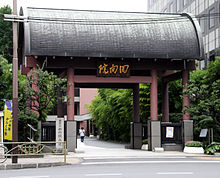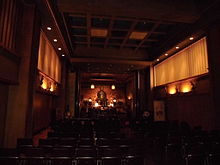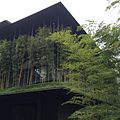Ekō-in
Ekō-in ( Japanese 回 向 院 , dt. "Hall of the karmic transfer of merit") is a Buddhist temple of the "School of the Pure Land" ( Jōdo-shū ) in the Tokyo district of Ryōgoku. The name refers to the karmic mercy of the Amida ( Amithaba ), which he gives to all living beings (Skr. Pariṇāmanā , Japanese ekō ).
history
On March 2, 1657, the Meireki fire broke out in Edo (now Tokyo ) , causing more than half of the city to go up in ashes and killing around 100,000 residents. Since most of the victims did not have a surviving relative who could perceive the burial, the shogun Tokugawa Ietsuna released a piece of land of around 900 × 900 m on the east bank of the Sumida River , where the remains were buried and a "burial mound of ten thousand" ( Banninzuka ). The priest Jun'yo Jōjin ( 遵 誉 上人 ) of the Zōjō Temple ( Zōjō-ji ), who also carried out the memorial and consolation ceremonies, was commissioned with the management . The Ekō-in adoration hall built by Jun'yo served from then on to comfort the soul of all those living beings who bless the temporal without relatives ( 無 縁 仏 , muenbotoke ), including victims of disasters and accidents as well as executed animals and animals (horses, dogs, cats, birds, etc.) .).
In 1793, by order of the mighty imperial councilor Matsudaira Sadanobu, a "water children hill" ( 水 子 塚 , mizukozuka ) was built here to bury and comfort the souls of stillbirths and aborted children. This is considered to be the beginning of the "water child consolations" ( 水 子 供養 , mizuko-kuyō ) in Japan.
Statues of the merciful Kanzeon ( Avalokiteshvara ) and the goddess of fortune Benzaiten also attracted the population. In addition, since about the middle of the Edo period , statues and images from other well-known temples, which were encircled or covered as "secret Buddhas" ( 秘 仏, 秘 像 , hibutsu , hizō ), were loaned and made public for a certain time. For example, on the occasion of the "external curtain opening" ( 出 開 帳 , de-kaichō ) of the famous Buddha from the Senkō Temple ( Senkō-ji ) of Nagano in 1778, several million believers made pilgrimages to the temple on the occasion of the 60 days .
The main deity of Ekō-in, a seated amida made of bronze, once stood outside the main hall as a so-called "wet Buddha" ( 濡 仏 , nurebotoke ). It was cast by Kamaya Rokuemon ( 釜 屋 六 右衛門 , nickname Kamaroku) in 1705 .
Sumo
In September 1785, with the permission of the government, a sumo wrestling event for the collection of donations took place in the area of the temple for the first time . From then on it served as a place for "charity rings " ( 勧 進 相撲 , kanjinzumo ) in Edo. Between 1833 and 1909 all of Edo's tournaments were held here. After 1909 the " National Sports Hall Ryogoku " built nearby was used , which was later replaced by the building used today. In 1937 the Japanese Sumo Association built a "power hill" ( 力 塚 , chikarazuka ) in the temple grounds in memory of deceased wrestlers.
Gravesites
On the site of the temple there are tombs of well-known personalities such as the Jōruri singer and founder of his own style Takemoto Gidayū ( 竹 本義 太 夫 , 1651–1714), the writer and ukiyo-e artist Santō Kyōden ( 山東 京 伝 , 1761–1816) and the popular thieving folk hero Nakamura Jirōkichi ( 鼠 小僧 次郎 吉 , 1797–1832) as the “Little Mouse Boy” ( Nezumi kozō ).
building
The temple buildings were destroyed and rebuilt several times in the course of their history by the frequent fires in Edo. In the 20th century, the Great Kanto earthquake in 1923 caused severe damage. The air raids on Tokyo towards the end of World War II again drove the temple into an existential crisis.
The current worship hall ( 念 仏 堂 , nenbutsudō ), completed in 2013, was designed by the architect Kawahara Yutaka ( 河 原 泰 ) in a modern style, which here and there cites the former forms.
Hall of the horse-headed Kannon (Batō-Kannon, skr. Hayagriva )
Grave of the writer and ukiyo-e artist Santō Kyōden
Web links
literature
- Ekō-in: Ekō-in yurai-ki . Tōkyō: Ekō-in, 1937 ( 回 向 院 由来 記 )
- Watanabe Makoto / Kikuchi Tōta: Ekō-in shi . Tōkyō: Ekō-in, 1992 ( 渡 辺 誠, 菊池 東 太: 回 向 院 史 回 向 院 )
Supporting documents and comments
- ↑ History of Ekoin . Ekōin website. Retrieved April 15, 2016.
- ↑ in the Japanese calendar the 18th day of the 1st month of the motto Meireki
- ↑ The news of this major fire reached Europe through the diary of Zacharias Wagener , who survived the catastrophe with his entourage, where it was spread through Arnoldus Montanus' "Gedenkwaerdige Gesantschappen [...] aen de Kaisaren wan Japan" .
- ↑ This Buddha is considered to be the oldest in Japan.
- ↑ In 2013, in support of the victims of the earthquake and tsunami in eastern Japan (2011), the same statue of the Senkō Temple was exhibited again.
- ↑ From the series 100 Famous Views of Edo by Utagawa Hiroshige . From a very similar tower, the start and end of the fights is still announced on every day of the tournament.











